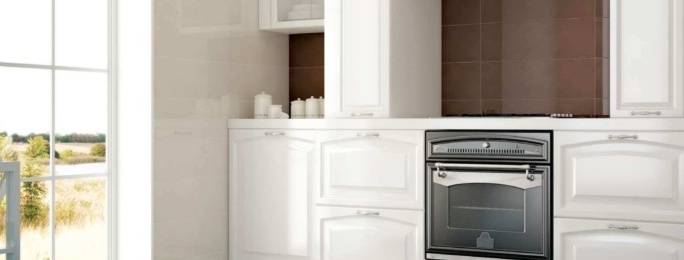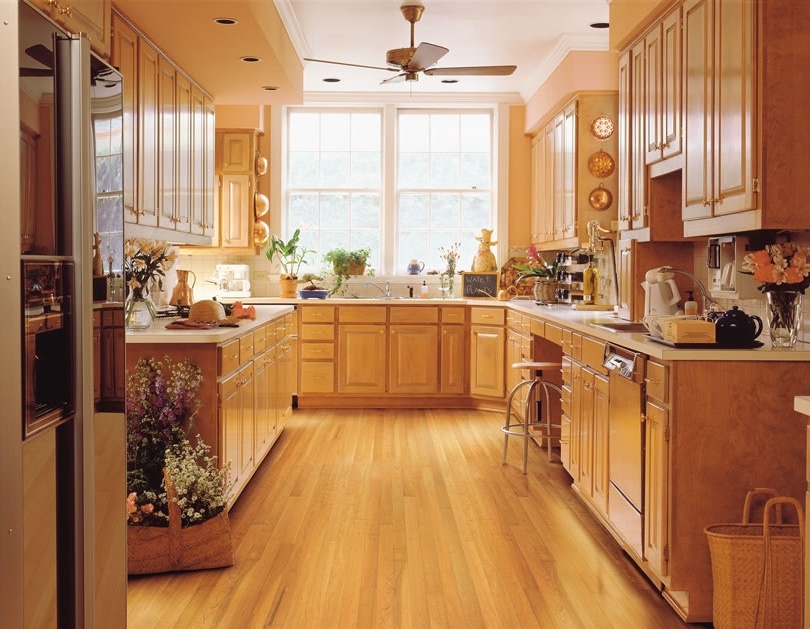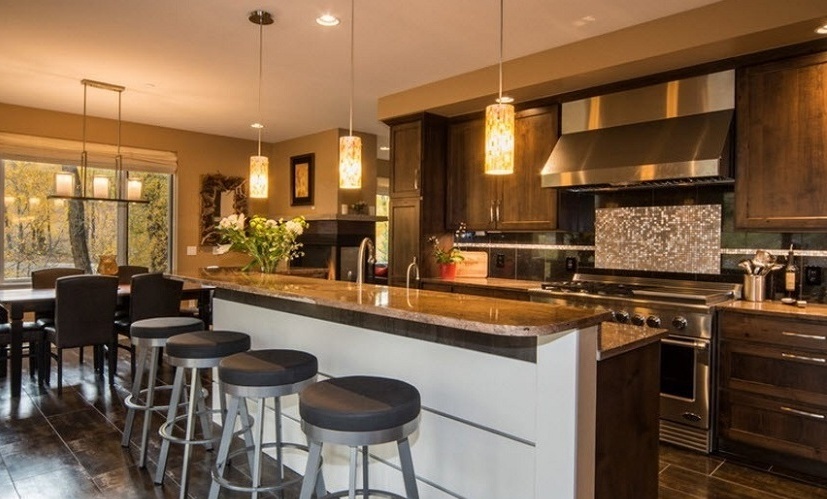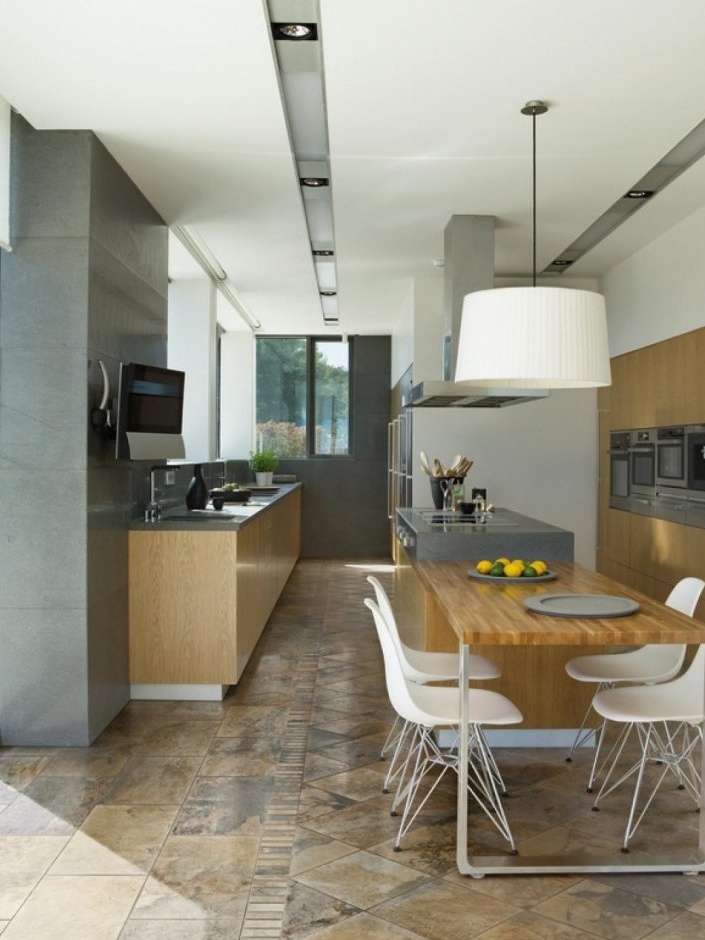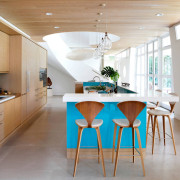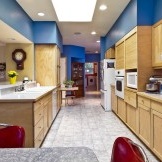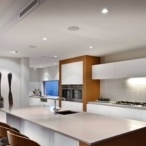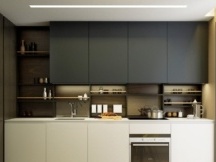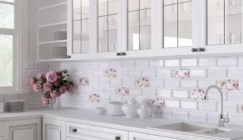Kitchen floor: tips for choosing the most suitable cover for you
Content:
- Which one should be?
- A natural stone
- Tree
- Laminate
- Porcelain Tiles
- Ceramic tile
- Brick
- Concrete
- 3 D floors
- Vinyl
- New materials
- Bung
- Floor in the kitchen-living room
- Color selection
- Small kitchen
The kitchen floor must be resistant to water and mechanical damage, and also easy to keep clean. Look at the flooring materials in modern kitchens, which are most often chosen for decorating rooms.
What floor should be in the kitchen?
The floor in the kitchen, especially in often cooked homes, is heavily used. And this leads to a spill of water, milk or butter, as well as the fall of the peel, heavy knives or pots, breaking eggs or glasses. Therefore, the ideal gender should be:
- easy to wash;
- resistant to stains, scratches and breakages.
It would also be nice if the floor in the kitchen is pleasant to the feet. The choice of finishing materials for this part of the room is huge, so the decision requires consideration. It is worth considering what is more important for you: practical or aesthetic considerations? Or maybe you can connect one to the other? Check out the overview of various materials. See what are the disadvantages and advantages of each. Choosing a kitchen floor is the solution for many years.


Two main elements determine which floor to choose for the kitchen:
- the first is durability, ease of care;
- second, it is important to integrate it into a holistic interior design.
The floor in the kitchen should be practical, but also decorate the room.
Natural stone floor in the kitchen: photos of beautiful ideas
Natural stone can be in the form of marble, slates, limestone, sandstone or travertine, but they all require more or less durable floor protection in order to serve for many years. From the point of view of strength, granite will be an almost ideal stone for the kitchen floor, since it:
- has a very high mechanical resistance, including abrasion;
- insensitive to moisture, high temperature;
- can be used in rooms with intensive use;
- chemically resistant.
Although the available colors and patterns will not please everyone, most varieties of this breed are characterized by a cold and heavy glow, granite has a completely different shade than, for example, marble, sandstone or travertine, which offer warmer colors. However, granite has a bizarre, unique and intriguing pattern, but it all depends on the individual taste.
Since this is a natural material, each option is different, therefore it will be unique. The material is excellent as it is scratch and break resistant. Some types have a porous rough structure and are prone to contamination, they can discolor and even absorb fat. Most stone floors require impregnation. Each stone for flooring has its advantages and disadvantages.

Benefits:
- natural;
- luxurious;
- very effective.
Disadvantages:
- cold and heavy;
- needs impregnation;
- expensive.
It is clear that you need to have a much larger budget compared to the amount needed to buy tiles, but, in the end, stone is an undeniable style and elegance. Stone care is simple, you just need to use cleaning products for this material.
Since this is a natural material, each stone (even of the same type) is different, so the floor will be unique. Such a floor has been used for years (especially granite), because the stone is resistant to scratches and breakages. Some types, however, have a porous, rough structure and are prone to contamination; they can discolor and even absorb fat. Most stone floors require impregnation.
Wooden floor in the kitchen
The wooden floor in the kitchen never goes out of fashion, but is it possible to use it in a given place at home, since the room is exposed to strong effects of splashes, stains, impacts of falling objects? Yes, but you should choose the right treatment and ensure safety. What if we have old boards or damaged parquet?
The wood floor will be definitely warm and not only visually, but also physically, to the touch. Wood also has good sound insulation, looks the most natural of all types of floors. The arrangement of the wooden floor carries signs of comfort. In the kitchen, you can spill something on the floor, a sharp object will fall, so the surface must be resistant to moisture and mechanical damage.
It is recommended to use harder and less sensitive to moisture species of exotic trees, since they have a low shrinkage rate, these will be teak, iroko, merbau, doussi or conditionally native deciduous species, for example, oak, ash, larch. Exotic species contain a large amount of tannins in resin oils, which has a positive effect, for example, on resistance to fungi.


Benefits:
- warms and drowns out the interior;
- the floor is warm and pleasant to the touch;
- timeless, elegant and durable;
- it can be updated.
Disadvantages:
- high price;
- demanding styling.
A wooden floor in a damp interior requires considerable care, so it must be lubricated with oil or varnish, but the first option is best to impregnate the wood, penetrating deep into its pores.
In the event of destruction, only parts of the surface of the oiled floor can be repaired, so that there will be no significant difference between the pieces of the surface. In the varnish version, here you need to clean and coat the entire floor with a solution to make it perfect. Oil, wax or another special preparation is able to emphasize the pattern and structure of the tree, while the floor will take on a very natural look. Glossy varnish will give the floor a shine, because it reflects up to 90% of the light. Semi-gloss varnish is also a good choice. If you want to emphasize the wood pattern, you can use the so-called “invisible” varnish, the floor will look damp. The only drawback of the oiled floor is the need for systematic application of paste and annual thorough impregnation. But the waxed surface requires even more care, it is in this case that the varnished version has the advantage of care.
Laminate on the kitchen floor
Laminate flooring will be the cheapest solution, but not the most practical. Almost perfect imitation of the structure of wood and patterns, a huge variety of colors and patterns prompts modern customers to purchase laminated panels. If you have already decided on it as a material for the floor, then make sure that the stationary surface is flat, without hollows and bulges on which the joints of the panels can deform. Laminate must have a wear class of at least AC4. It is difficult to damage such a floor with anything sharp, in this respect it will be better than even the hardest wood. The disadvantage of the laminate is its high sensitivity to moisture, which can lead to a rise at the joints due to irreversible swelling of the MDF layer. Although there are special, more expensive panels on the market with elastic tape / gasket in the joints, this to some extent prevents the penetration of water, but not completely, because this finish is a floating floor. Remember that a laminate flooring will never be as durable and insensitive to moisture as a surface such as glazed porcelain stoneware or natural stone.
Porcelain tiles for the kitchen floor
Porcelain tile is a material with:
- low water absorption;
- very high abrasion resistance;
- confrontation to various spots;
- cleaning with standard detergents;
- problematic damage to the surface with a hard and heavy object.

Polished porcelain stoneware is as hard as glazed, but it has a much higher water absorption, which makes it easy to stain it, for example, with coffee, wine, fruit juice or ink, although it can be cleaned with a special stain remover, but it is quite troublesome. If polished, it can disappear for many years in more exploited places, but it certainly has its own charm, characterized by a more intense color. Polished porcelain stoneware looks more natural, but because of its microporosity, it requires impregnation immediately after laying.
Porcelain tile is different from terracotta or clinker. These tiles, in comparison with hard ceramics, wear out faster and break more easily. There is also a natural and technical material called gres. It has all the advantages of glazed tiles, except for aesthetic value, as it has slightly different proportions of components. The composition of the material includes high-quality clay, affecting the aesthetics and color diversity. You can see the natural grit on the terraces or stairs, although some collections of tiles may correspond to the interior of the kitchen, but in an extremely minimalist, almost ascetic style. Ceramic tiles on the floor of the cooking room are the most common option.
Gres is a type of very hard ceramic tile. It can be polished, it looks spectacular, but is not resistant to stains and dirt that get into micropores, so it is worth it to be soaked. A tile called glazed gres does not require impregnation, as it does not stain and does not absorb moisture. Unfortunately, as a result of, for example, hitting or dropping a heavy object, a piece may break off. You can choose from a variety of surface finishes, including polished, satin, lappato. Gres will ideally mimic natural materials such as wood or granite.
Ceramic tile for the kitchen on the floor
Ceramic tiles for the kitchen on the floor are extremely popular and are produced in countless sizes, designs and colors. Everyone will easily choose the option that suits both the style of the kitchen and the taste. In modern design, homogeneous polished tiles with a size of 60 x 60 cm are suitable, rustic - matte with uneven edges, a bit like a stone. In turn, wood tiles will make the interior more comfortable. You can easily find tiles at a price that suits.
Benefits:
- resistant to damage, abrasion;
- easy to clean;
- can find cheap and pleasant options;
- It looks beautiful and elegant;
- There is a large selection of patterns and colors on the market.
Disadvantages:
- the floor is hard and cold, so you should consider heating;
- if a heavy object falls, it may be damaged;
- polished material is very slippery, especially wet.

Kitchen floor design - brick
Brick flooring is a relatively rare but extremely interesting solution. Gives the interior a somewhat old-fashioned and rustic look. It works well in a stylish country house or in an apartment in an old house. Few people today decide to install such a floor in a newly built house, but if you bought a house with this finish, do not change it for another.
Benefits:
- very decorative and original;
- durable.
Disadvantages:
- bulky masonry;
- the brick floor is heavy;
- not very resistant to dirt because it has an uneven surface.


Kitchen floor - concrete
Concrete floors are ideally combined with a minimalist interior with large glazed areas, as well as with an industrial and attic design. Smooth concrete surfaces optically increase the space and provide an excellent neutral background for kitchen furniture and accessories. They blend perfectly with any kind of tree. With the help of special paint you can paint such a floor as a whole or according to a drawing using a template.
Benefits:
- relatively cheap solution;
- the floor is durable, resistant to abrasion and cracking;
- easy to clean (no gaps), maintenance-free.
Disadvantages:
3 D floors - a kitchen with a chic design of resin
Resin offers excellent accommodation options. It allows you to get a large smooth surface without joints, making the room seem larger. You can choose from a wide range of colors (resin can be painted). Such a floor is lined with gloss, mat or half gloss.
Benefits:
- not heavy to install;
- there are no spaces, so it is easy to keep clean;
- warm to the touch.
Disadvantages:
Resin floors find many uses in industrial facilities, in public buildings, as well as in private homes. 3D floors are created thanks to this material. Decorative floors are a solution that will allow you to equip a unique and original residential interior. A 3D enriched resin floor is a functional solution. Discover the application and benefits of three-dimensional resin floors.
Resin floors are widely used because of their ease of use and visual appeal when it comes to decorative properties. Depending on the type, there are a lot of options. Resin floors meet the interests of investors due to their good characteristics, durability and strength, as well as aesthetic appearance. 3D epoxy floors can have different colors and textures. They allow you to produce both matte and glossy options. 3D floors are suitable for a bathroom or kitchen, less often they are used in residential or other rooms.
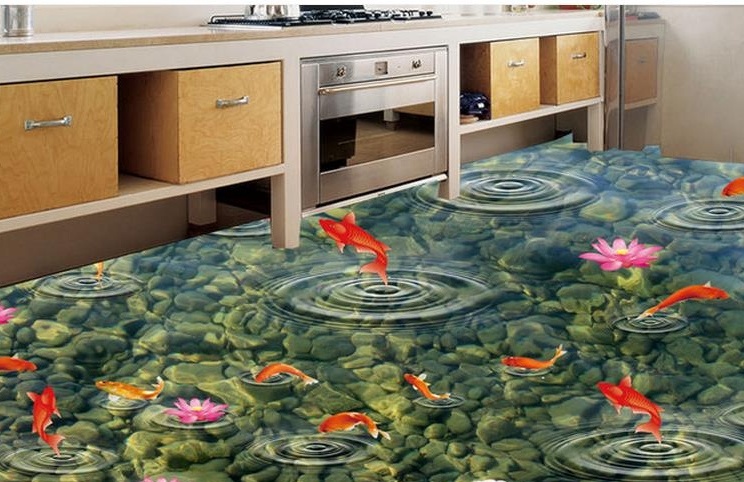
Types of resin floors
Floors are made from various types of resins. Epoxies are one of the most commonly used. Colorful decorative floors can be created with epoxy. The surface will have high abrasion resistance and good adhesion to the base. It is chemically stable and easy to clean.
Polyurethane resin floors are another type. It has very good strength indicators, resistance to abrasion and chemicals. Due to the lack of sensitivity to light, polyurethane resin floors can also be used outdoors, for example, on the surface of external stairs or terraces.
There is also a group of industrial floors in which resins are enriched with various components to increase resistance to mechanical stress. This group includes polyurethane-cement floors, which are intended for use in buildings with very high thermal, chemical and mechanical loads. Floors for industrial use are also made of resin in combination with quartz aggregate. They are used in places with heavy traffic. Resin floors are also made from polyester and methacrylic resins, which have good chemical resistance.
Kitchen Vinyl Flooring
Flexible and easy to install vinyl floor allows you to quickly carry out metamorphosis inside. And when you get tired, it is easy to remove such a coating yourself, without taking up much time. The price is comparable to laminated panels, but does not give an unpleasant “knocking” effect. New generation vinyl floors also perfectly mimic natural materials such as wood, ceramics and stone. The range of design is almost unlimited, so the coating is easy to choose according to your interior style.
Benefits:
- can be laid on old floors;
- warm and pleasant to the feet;
- waterproof and non-slip coating;
- inexpensive material.
Disadvantages:
Kitchen floors: which is better from new materials?
EcoMalta - quartz solution. The main ingredient is quartz, other minerals and aggregates.The solution dries and becomes hard, very resistant to temperature changes, abrasion, mechanical damage. It is also a moisture resistant, washable floor that does not fade. Thanks to its high flexibility, you can get up to several tens of meters of a continuous, smooth surface. Such a surface gives the interior a slightly damp, industrial look, but unlike materials containing cement, it is warm and pleasant to the touch. However, it can be attributed to ecological floors, as it does not contain cement, lime, plaster, epoxy resins. The diluent is water, due to which it does not cause allergies, does not increase the production of CO2 and does not dry the air inside. EcoMalta has a thickness of 2-3 mm and can also be used for underfloor heating.
Laminam - sintered quartz. It consists only of quartz and water, so it is 100% natural. Thanks to special technology, the mixture is subjected to very high temperature and high pressure, creating an extremely hard material. Boards are made in the formats 324 x 162 cm and 300 x 100 cm. They have better performance than natural stone, as they are durable, resistant to mechanical damage, high temperatures and staining (for example, fruit acid, wine). The material does not discolor and does not change its appearance over the years.

Underfloor heating in the kitchen - cork
Cork is natural and environmentally friendly. It perfectly insulates thermally (comparable to polystyrene and mineral wool) and acoustically. The material is flexible, as it lends itself to pressure, but quickly returns to its previous state. It is easy to install because it has the form of tiles or panels. The kitchen should be covered with a layer of moisture-proof varnish. The cork is warm to the touch and electrostatic, as it does not attract dust, therefore it is safe for allergy sufferers. The material is resistant to mold and mildew. In contact with fire, it lights up with difficulty and slowly. The interiors lined with cork seem more comfortable, and most importantly - warm.
Benefits:
- the floor is warm and pleasant for bare feet;
- soft, flexible and non-slip;
- improves internal acoustics.
Disadvantages:
Floor in the kitchen-living room
As mentioned earlier, the floor is increasingly lined with one material on the entire surface of a house or apartment. Thus, you can optically increase the space and create a consistent arrangement. A very interesting visual effect can be achieved when, after crossing the threshold from the hallway level, you see that the floor in other rooms, including the kitchen, was lined with the same material. This type of stylistic coordination gives the interiors a harmonious expression.
Some designers do not approve of using the same material on the floor in all rooms, so if the kitchen is combined with the living room, it is worth considering the possibility of lining the surface with different materials in this space, especially if you want the kitchen and living room to form an interesting tandem. This is a very common solution that allows you to create a fashionable and stylish living space.

Kitchen floor color
The floor in the kitchen should match the color of the interior, as well as in harmony with other rooms. Therefore, a good and increasingly used solution is laying in the whole house or apartment with one material. When choosing a color, remember that the kitchen floor should be versatile and timeless enough to look good when changing furniture or accessories, and, despite the duration of use, it still pleased with its impeccable beauty.
White floor in the kitchen
It may seem that the white floor will not work in the kitchen, however, due to proper impregnation, it can be protected from stains or other dirt. Thanks to several coatings using UV technology, the floor will meet high quality criteria. It is very important that the varnish layer does not create an artificial effect on the boards, because the natural structure of the oak stands out from under it.Thus, the white floor is both practical and beautiful.

Bright floor in the kitchen
The bright kitchen floor is not just white. You can also choose boards coated with clear or slightly colored oils or varnishes. Many interesting offers can be found in the photo gallery. People who prefer bright kitchen floors, which delight with their naturalness, will surely like such boards as: honey, vanilla, champagne, glade, etc.


Gray floor in the kitchen
Nowadays, gray is very popular in interiors. Today you can choose colors in several shades. Among them are boards: white and gray pearl. The gray floor fits very well in the kitchen with white and brown furniture.
Dark floor kitchen
The subfloor is more of a solution for courageous people who like brighter color accents in the interior. It will look especially good against a light background in the form of walls, furniture and other equipment. Thus, you will not overload the room, but rather increase its visual qualities.
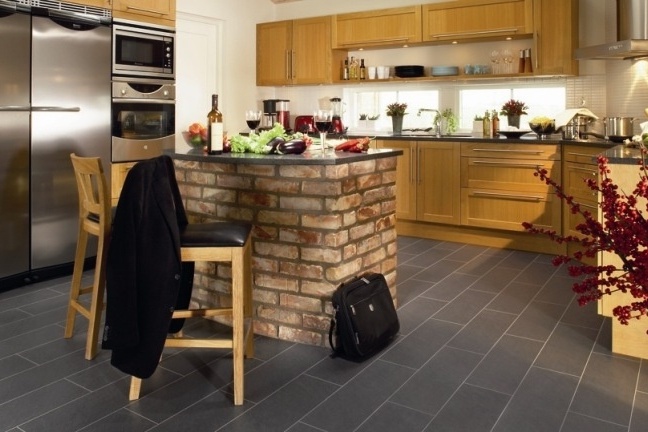
Black and white floor in the kitchen
You can not choose one color of the kitchen floor? Maybe in this case you will like the idea of combining white and black boards arranged, for example, in French, Hungarian or traditional herringbone designs. The method of laying the floor in the Christmas tree is again very fashionable now, and it looks stylish. It can be used both in modern and traditional interiors. Such a floor will give the interior any class and elegance. Consider a checkerboard that offers virtually unlimited possibilities when it comes to perfect kitchen interiors.
Kitchen floor in a small apartment
There are many ways to optically expand a small apartment - you can do it with the right wall layout and lighting, as well as with a smart choice of furniture and decorative accessories. When designing interiors with a small area, you should also pay attention to the design of the floor. What types of surfaces are best suited for small apartments and what tricks will help you in the optical increase in space?
Floors are one of the most important surfaces in the house - in addition to walls and ceilings, they occupy a large area of apartments. Due to this, their appearance is strongly influenced by other elements of the interior, which is a particularly important factor in the arrangement of a small apartment.
Floor in a small kitchen: bright, shiny, uniform
For a small apartment, it is best to choose light floors - reflective, and most importantly uniform. Light colors optically enhance the interior and also reflect natural and artificial rays on shiny surfaces. A small apartment will also get more space if it has the same floors in all interiors. Ideally, the surface should be made of light wood (beech, ash, oak or acacia) or from exotic species (hevea, tauari, light bamboo), as well as laminated panels. Floors can be made of bright, shiny terracotta, as well as resin. When choosing porcelain stoneware, choose a large format tile (60 × 60 cm or 90 × 30 cm). The less noticeable the joints of the material in the kitchen, the smoother, which means the floor looks more.

Optical Tricks
Using the right floor, you can also change the proportions of the interior. The alternation of light and dark stripes shortens and optically expands the narrow and long kitchen. In turn, a rhythmically repeating decorative element (for example, ceramic tiles) increases the space without changing the proportions of the interior. You make the room too short by placing the same elements parallel to shorter walls.
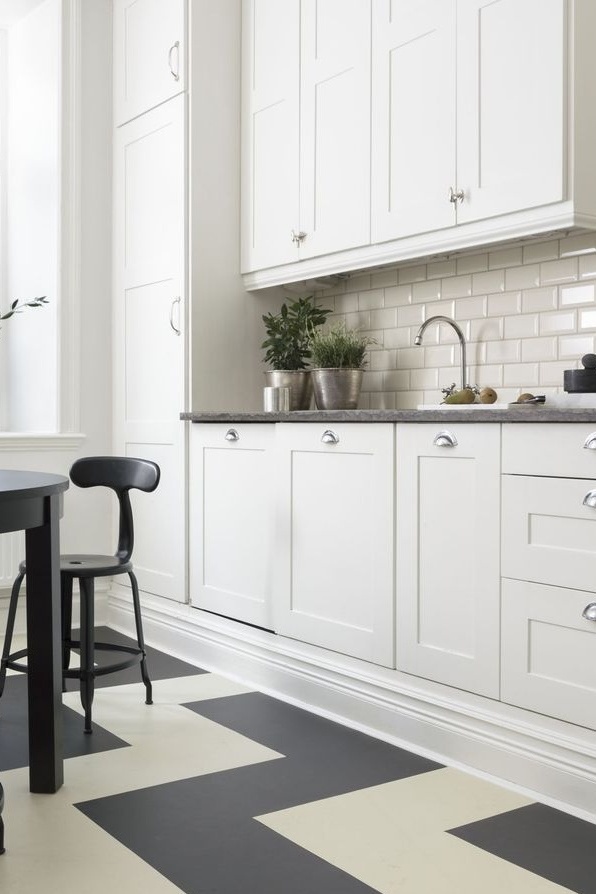
When choosing a kitchen floor, keep in mind that it will function in the context of other materials and surfaces. So what to do? Are there any prohibited materials? It is worth the risk, as many types of finishes are allowed. You can choose a strategy based on creating contrasts, combine wood with ceramic tiles, concrete floor with stone, various textures and patterns with each other.



















